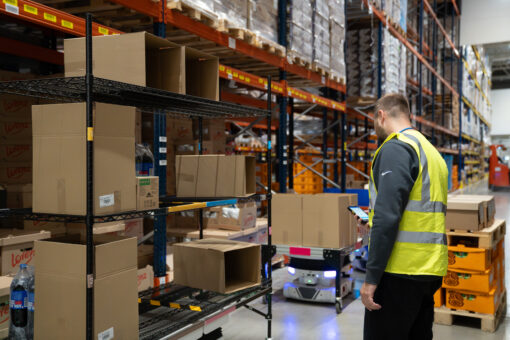WP: How to achieve 400 UPH with Locus Fast Pick
WP: How to achieve 400 UPH with Locus Fast Pick Download Now!
How to Handle Warehouse Labor Challenges with Automation
Mary Hart, Sr. Content Marketing Manager

The logistics, fulfillment, and warehousing industry is facing a perfect storm of labor challenges. Many thought that the labor issues in warehouses and other sectors would lessen as time passed from the start of the pandemic — but instead, hiring remains a struggle for many. Customers are returning to stores, but they haven’t forgotten nor moved away from the ability to order something online and have it delivered directly to their house instead of having to shop in-person. As demands for speed and efficiency continue, how can the industry survive — and even thrive — despite significant labor shortages? Enter warehouse automation — the solution for warehouses that want to tackle their labor-related hurdles and improve their operations at the same time.
The Labor Challenge in Warehousing
Warehouse labor challenges are numerous across industries from manufacturing to retail and 3PLs, but one of the most pressing issues is the persistent labor shortage. According to a recent FreightWaves survey, approximately 73% of warehouse operators report difficulties in finding enough labor to meet operational needs.
The lack of labor isn’t helped by the physically demanding nature of warehouse jobs, which often leads to high turnover rates and difficulty attracting new talent. Additionally, labor-intensive transportation and warehouse operations are suffering significantly, with 56% of respondents to a Descartes survey noting resource shortages.
With the high turnover rates, you need to consider the cost of replacing your current associates, which is estimated at $8,500 per warehouse associate. This includes the cost of developing training programs, paying for trainers, and the loss of productivity while new hires are brought up to speed.
Moreover, the nature of consumer expectations has shifted dramatically. Modern consumers expect rapid delivery times and a high level of service, putting immense pressure on warehouses to operate more efficiently and accurately to keep up with their competition. This pressure is compounded by seasonal peaks, such as during the holiday season, when order volumes can skyrocket and stretch labor resources to their limits.
3 Ways Automation Alleviates Warehouse Labor Shortages
By automating your warehouse with advanced technologies such as robotics, artificial intelligence (AI), and machine learning, you can significantly improve your efficiency and productivity while mitigating the impact of labor shortages.
- Productivity and Efficiency
Automated warehouse systems can operate continuously without fatigue, ensuring that you maintain high levels of productivity around the clock. Automated guided vehicles (AGVs) and autonomous mobile robots (AMRs), for example, can transport material across your warehouse efficiently, reducing the need for manual physical labor and minimizing the time for travel. AMRs work collaboratively with humans, handling repetitive and physically demanding tasks, thus allowing human associates to focus on more complex and value-added activities.
- Turnover and Hiring
By automating the most strenuous and repetitive tasks, warehouses can create a more attractive, and less stressful, work environment. This can lead to lower turnover rates as associates are less likely to experience the physical strain that often leads to job dissatisfaction and burnout. Moreover, a modern, tech-driven warehouse can be more appealing to younger workers who are drawn to innovative workplaces that leverage cutting-edge technology.
Increased wages are another strategy that has been employed to attract and retain workers. According to a When I Work article, warehouse workers have seen wage increases that often surpass those in other industries, such as the restaurant sector, making it challenging for warehouses to attract and retain employees without offering competitive pay and benefits.
- Consumer Expectations
Automation enables warehouses to meet the heightened expectations of today’s consumers. With robotic systems working alongside human associates, warehouses can process orders faster and more accurately, ensuring timely deliveries and reducing the likelihood of errors. During peak seasons, you can scale up your fleet of AMRs easily and quickly with Robots-as-a-Service (RaaS) operations quickly to handle increased order volumes, ensuring that customer service levels remain high even under pressure.
Top Benefits of Associates and Robots Working Together
In top-performing warehouses, human associates and AMRs operate side by side. This collaboration can lead to a more efficient and harmonious working environment, combining the strengths of both humans and machines to improve the warehouse in three ways
- Upskill Associates
Rather than replacing human associates, automation augments their capabilities. Robots can take on the mundane and physically taxing tasks, while human associates can focus on tasks that require critical thinking, problem-solving, and customer interaction. This division of labor can lead to higher job satisfaction and better overall performance ,which can improve your associate retention rates.
- Continuous Learning and Adaptation
The integration of AI and machine learning into warehouse operations allows for continuous learning and adaptation. Automated systems can show detailed performance to help human decision-makers adjust their warehouse operations to improve efficiency. This adaptability is crucial in a rapidly changing market where consumer preferences and demand patterns can shift quickly.
- Embrace Technological Advancements
To remain competitive, warehouses must embrace technological advancements and continuously innovate. This requires ongoing investment in new technologies and a commitment to training employees to work effectively with automated systems. By fostering a culture of innovation, warehouses can stay ahead of labor challenges and meet the demands of the modern supply chain.
Automate Your Warehouse with Locus
Locus Robotics' AMRs are designed to work collaboratively with human workers, significantly enhancing productivity and efficiency and addressing the most pressing labor challenges in the warehousing industry. These robots can seamlessly integrate into your existing warehouse operations, providing a scalable and flexible solution that can seamlessly adapt to changing demands.
By taking on the physically demanding tasks of transporting goods and picking orders, Locus Robotics' solutions allow your human associates to focus on higher-level tasks, improving job satisfaction and reducing turnover.
Moreover, Locus Robotics offers a comprehensive suite of analytics and reporting tools that provide valuable insights into warehouse operations. These tools enable you to optimize your processes, forecast demand more accurately, and maintain high levels of service even during peak periods.
Want to find out how our AMRs can help you handle your warehouse’s labor challenges while improving productivity? Let’s talk!




